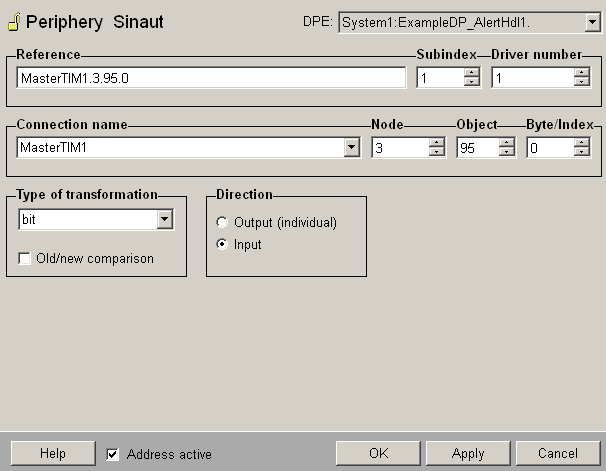Defining the peripheral addresses of the SINAUT driver
For the definition of the peripheral address click on the address config of a data point element, select the driver type Sinaut ST7 from the combo box and click on the Configure... button. This opens the panel for defining the peripheral address of the SINAUT driver (see figure above).
The peripheral address (reference string) can either be entered directly in the "Reference" input field or can be composed of the single components by using the combo boxes and spin button. The reference string consists of the following fields:
<ConnectionName>.<Node>.<Object.<Byte/Index>

Subindex
The subindex of the SINAUT driver depends on the type of transformation. More precisely, this can be set for the "bit" type of transformation only. Its value range lies between 0 and 7 (1 byte). For all other types of transformation the subindex is by default 0.
Driver number
Number of the corresponding manager that starts the SINAUT driver (e.g. -num 4).
Connection name
Name of the internal data point for the connection. After configuration of the SINAUT driver this is provided automatically.
Node
Node number.
Object
Object number. A SINAUT object contains the data of one or several process factors, e.g. analog values, commands, calculation values, state details on motors, register, etc..
Byte/Index
The Byte Index specifies a telegram and additionally the index within the organizational telegram.
Peripheral address for accessing organizational data:
<Master_TIM>.<NodeNumber>.32767.<ORGNumber+Byte/Index>
The object number 32767 is reserved for the access on organizational data.
Example 1
Access to node 2, object 55, byte 0:
MasterTIM1.2.55.0
If the length is e.g. 8, then the telegram contains e.g. 2 values of the type float32 and thus 2 peripheral addresses with the indices 0 and 4 are possible.
Example 2
Getting ORG4 for node 2, byte 1 (counting from 0), bit 0.
This bit contains the information whether node 2 is reachable by the Master TIM or not.
The peripheral address is made up as follows:
MasterTIM1.2.32767.5, Subindex 0, bit type of Transformation.
Type of transformation
Select from the combo box a type of transformation. The type of transformation is a interpretation of data that has been sent by the Master TIM. The transformation has to equal to the address (if, for example, 4 bytes are read from the node, the type of transformation has to be e.g. int32).
The following table shows the general transformation of FB data types to WinCC OA data types. By default the type of transformation is set to undefined. This type shall remind the user to set a valid type of transformation (see table below). If not, an error message is written to the WinCC OA log viewer.
| Symbolic function block name (FB, data point typical) | FB type (transformation) | WinCC OA DPE data type | Function |
|---|---|---|---|
| Bin04B | bit/bit32 | bit/bit32 | ST7 notification object , 4 byte notifications / binary information |
| Cnt01D | uint28 | unsigned/int | ST7 counter object, 1 counter (32 bit ST1 format), supported in receive direction only |
| Cnt04D | uint28 | unsigned/int | ST7 counter object, 4 counters (32 bit ST1 format), supported in receive direction only |
| Set01W | int16 | int | ST7 set point object, receive 1 set point (16 bit) and send current local set point |
| Ana04W | int16 | int | ST7 analog value object, 4 analog values (16 bit value in INT format) |
| Cmd01B | bit | bit | ST7 command object, 1 byte commands(1-from-8 ST1 format). Only sending 1 (TRUE) is supported. Sending 0 (FALSE) is not allowed. |
| Par12D | float32 | float | ST7 parameter object, sending max. 12 double-words with parameters and current local parameters |
| Dat_12D | float32 | float | ST7 data object, max. 12 double-words with any data content. |
Old/new comparison
This option can be activated only then, when the direction is set to input. This option causes that data will be sent only if they have changed. This comparison is based on raw data without conversion. The old/new comparison is already executed with the data, which have been received from the Master TIM (in opposition to smoothing, where the data are already pointed at the data points). A old/new comparison compares the new bits of a byte block with the old values and replaces them accordingly in case of an inconsistency.
Direction
Defines whether the values of a data point element are transmitted in send direction (Output) or receive direction (Input). All commands are sent to one destination address or received from one source address. The destination/source address is precisely specified by the node number, object number and the byte/index.
The spontaneous receive mode is supported by the SINAUT driver. Polling not.
Address active
If the check box "Address active“ is ticked, the driver address will be used (see Reference Tables). An inactive address may be possible and the attributes can be set and queried, but will not be used by the driver. That means, that no values can be sent by the Master TIM or can be received from the Master TIM for this data point element.



